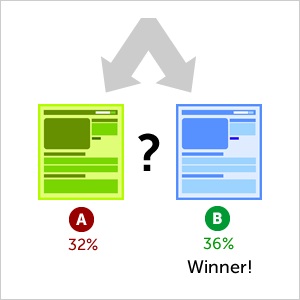Maximize Conversions With Autonomous A/B Testing
Like any other art form, web design is completely subjective. A web site might look like a thing of beauty to one person, and a complete mess to another person. There is, after all, no accounting for taste, and everyone’s tastes are different. However, there’s more to a web site’s design than merely its appearance. A web site design can have an enormous impact on conversions and even the most subtle design decisions can have a big effect. For example, a user might be more inclined to click on a green “Buy Now!” button more so than a red one. Finding a good balance between a site that looks good and a site that performs well in terms of conversions can be a real challenge.
How then can something as subjective as web design be analyzed in an objective manner to find the most effective design? One widely technique is A/B testing. In a nut shell, A/B testing sets up two or more control groups: Group A will see one version of the site, while Group B will see another version. This way various design elements can be tested and compared.
But is A/B testing really the best way to determine the most effective web design? Perhaps not. This excellent blog post by Steve Hanov suggests another method for finding the best design. Best of all its fully automated. Set it, forget it, and the page will “learn” which elements result in the most conversions.
In his post, Steve outlines the epsilon-greedy algorithm, also known as the multi-arm banded problem. Given a set of variations for a particular page element, the algorithm can make an ‘educated’ decision on which element to show based on its past performance. The best performing page elements are displayed the most frequently.
The algorithm records of the number of times a particular page element was displayed, and the number of times the element resulted in a conversion. However, the algorithm will also adapt to change. If a page element’s conversions begin to decrease, the algorithm will start to adapt and display different variations. The best part of this is that you can set up different variations of page elements one time, and let the computer do the work of figuring out which variations are the most successful. Pretty neat stuff!
Armed with this knowledge, I set out to try a few experiments with it, the result of which is Robo_AB_Tester, a small PHP class library I created which implements the epsilon-greedy algorithm. You can give it a try here.
Robo_AB_Tester tries to abstract away as many implementation details as possible and create a simple interface that is, hopefully, easy to integrate into a PHP based website. Once it is set up, it will:
- Allow you to test multiple elements per page
- Allow you to specify any number (A/B/C/D/E…) variations of each element.
- Detect on page events for the tested elements (e.g clicks, form submits, etc)
- Handle all ajax communication between your web page and Robo_AB_Tester
- Keep track of how many times the elements were displayed
- Keep track of how many times a user interacted with the element
- Autonomously determine the best performing elements
For more details, see the demo page.








